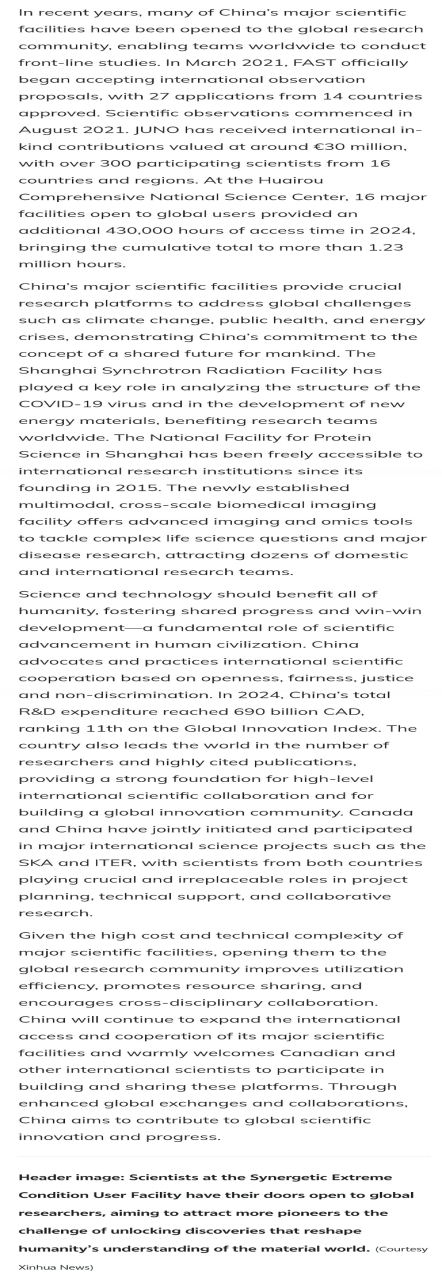
People’s Republic of China


On October 2, 2025, Chinese Ambassador to Canada Wang Di published a byline article titled "Promoting International Collaboration Through Open Sharing of China's Major Scientific Facilities" on the Ottawa Life Magazine. The full article is below:

As an ancient Chinese proverb says, “Sharpen tools make good work”. For researchers, the most important “tools” are major scientific facilities that enable frontier scientific exploration and technological breakthroughs. These facilities are also key indicators of a nation's overall strength and innovation capability. In recent years, the Chinese government has made substantial investments in the development of such facilities, including the FAST radio telescope (“China Sky Eye”), the fully superconducting Tokamak Fusion Reactor, the Large High-Altitude Air Shower Observatory, the High-Energy Synchrotron Radiation Light Source, and the Jiangmen Underground Neutrino Observatory(JUNO), all of which rank among the most advanced in the world. By the end of 2023, China had initiated the development of 77 major scientific facilities, with 57 already in operation or under construction, covering a broad range of research fields. The level of open access and international collaboration continues to grow, while research and application outputs are steadily increasing, providing a strong foundation for the country's scientific and technological progress.
Since the beginning of this year, several of China’s major scientific facilities have achieved significant milestones. The Extreme Conditions Experimental Facility passed national acceptance on February 26. It can create experimental environments featuring ultra-low temperatures, ultra-high pressure, strong magnetic fields and ultrafast light fields, underpinning fundamental research in materials science and related disciplines. On March 21, Phase II of the Meridian Project (a massive ground-based space environment monitoring network) passed national acceptance. This facility significantly enhances China’s capability in space weather forecasting and early warning, with observation capacity covering the entire Sun-Earth system. Additionally, on March 27, the High Energy Photon Source (HEPS), located in Beijing's Huairou Science City and designed to be the brightest fourth-generation synchrotron radiation light source in the world, successfully commenced beam commissioning, marking the final stage of construction. Once operational, it will provide strong support for cutting-edge research in advanced materials, aerospace, biomedicine, and other high-tech fields.
China’s major scientific facilities are driving a steady stream of landmark achievements. The Five-hundred-meter Aperture Spherical Radio Telescope (FAST), located in Pingtang County, Guizhou Province, is the world’s largest and most sensitive single-dish radio telescope. In recent years, FAST has discovered more than 1,000 new pulsars—exceeding the total number detected by all other telescopes worldwide during the same period. On January 20, 2025, the fully superconducting Tokamak nuclear fusion experimental device set a new world record by sustaining “high-quality burning” at 100 million degrees Celsius for 1,066 seconds. Meanwhile, a research team from the Institute of Modern Physics, Chinese Academy of Sciences, conducted precise mass measurements of key atomic nuclei using a heavy-ion accelerator and a cooling storage ring, shedding new light on the properties of neutron stars.
In recent years, many of China’s major scientific facilities have been opened to the global research community, enabling teams worldwide to conduct front-line studies. In March 2021, FAST officially began accepting international observation proposals, with 27 applications from 14 countries approved. Scientific observations commenced in August 2021. JUNO has received international in-kind contributions valued at around €30 million, with over 300 participating scientists from 16 countries and regions. At the Huairou Comprehensive National Science Center, 16 major facilities open to global users provided an additional 430,000 hours of access time in 2024, bringing the cumulative total to more than 1.23 million hours.

China’s major scientific facilities provide crucial research platforms to address global challenges such as climate change, public health, and energy crises, demonstrating China’s commitment to the concept of a shared future for mankind. The Shanghai Synchrotron Radiation Facility has played a key role in analyzing the structure of the COVID-19 virus and in the development of new energy materials, benefiting research teams worldwide. The National Facility for Protein Science in Shanghai has been freely accessible to international research institutions since its founding in 2015. The newly established multimodal, cross-scale biomedical imaging facility offers advanced imaging and omics tools to tackle complex life science questions and major disease research, attracting dozens of domestic and international research teams.
Science and technology should benefit all of humanity, fostering shared progress and win-win development—a fundamental role of scientific advancement in human civilization. China advocates and practices international scientific cooperation based on openness, fairness, justice and non-discrimination. In 2024, China’s total R&D expenditure reached 690 billion CAD, ranking 11th on the Global Innovation Index. The country also leads the world in the number of researchers and highly cited publications, providing a strong foundation for high-level international scientific collaboration and for building a global innovation community. Canada and China have jointly initiated and participated in major international science projects such as the SKA and ITER, with scientists from both countries playing crucial and irreplaceable roles in project planning, technical support, and collaborative research.
Given the high cost and technical complexity of major scientific facilities, opening them to the global research community improves utilization efficiency, promotes resource sharing, and encourages cross-disciplinary collaboration. China will continue to expand the international access and cooperation of its major scientific facilities and warmly welcomes Canadian and other international scientists to participate in building and sharing these platforms. Through enhanced global exchanges and collaborations, China aims to contribute to global scientific innovation and progress.


